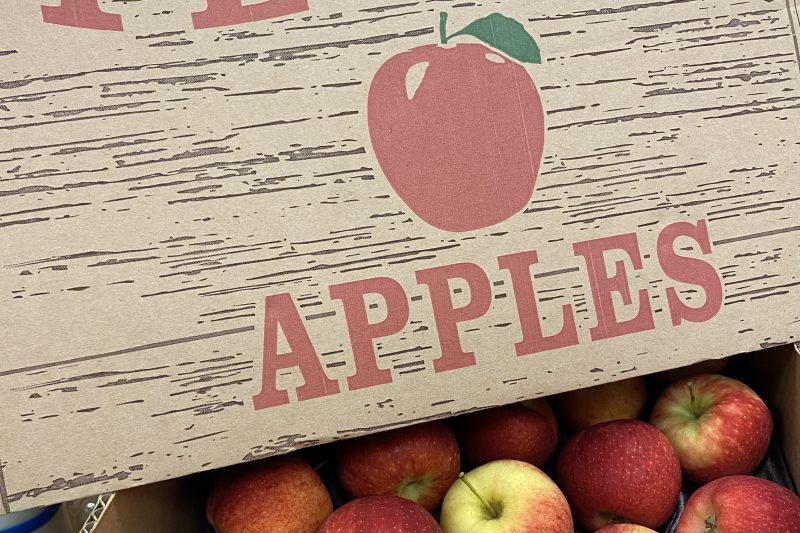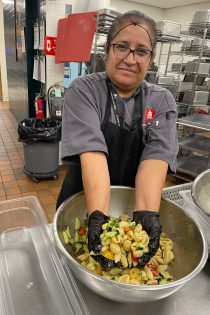Lunches for Texas Students Expected to Suffer After USDA Pulls Plug on Local Food for Schools Program
By Madeline de Figueiredo and Rebecca Butler
Reporting Texas

Using money from the Local Food for Schools initiative, the Austin school district bought apples from Texas farms in Idalou. The U.S. Department of Agriculture recently ended the program. PHOTO COURTESY OF AISD
The U.S. Department of Agriculture abruptly canceled a federal program that brought fresh, locally-sourced food to Austin school cafeterias last month — a move that gutted funding for the Austin Independent School District and severed revenue streams for Texas farmers who supplied public school districts.
The Local Food for Schools initiative was set to distribute $660 million to state agencies in fiscal 2025, aiming to help schools and child care facilities buy locally grown food in 40 states. The program connected local farms to lunchrooms across the country, bringing fresh, nutrient-dense foods to school lunch trays. In the days after the USDA announced over $1 billion in cuts for local food assistance programs, the federal Department of Health and Human Services said continued cuts and layoffs were part of the Make America Healthy Again initiative.

An Austin school district cook makes a pasta salad with parsley from Rio Fresh farms in San Juan and tomatoes from Village Farms in Marfa. The parsley and tomatoes were purchased with Local Food for Schools program funds. PHOTO COURTESY OF AISD
The end of the Local Food for Schools program eliminates more than $600,000 that the Austin school district used over the past two years to buy high-quality products like pasture-raised beef, organic yogurt and fresh produce from across the state. Without that support, AISD officials said they’ll have to turn to cheaper, commercial suppliers — a move affecting both student nutrition and local food economies.
“When you see critiques of school food, you see people saying we want fresh food, we want scratch cooking and we want local stuff,” said Diane Grodek, the executive chef for AISD. “The LFS grant provided us access to those very things that people wish we were doing more of — and now it’s just been removed.”
Lindsey Bradley, marketing specialist for AISD, said that the district has a $10 million annual food budget. This budget is made up entirely of USDA funds from programs like the Child and Adult Care Food Program, the School Breakfast Program and the Seamless Summer program.
“Our entire operation is fully funded by USDA,” Bradley said. “Generally, all public school meal programs are going to be operating federal meal programs.”
The district received $250,000 from the LFS program in the 2023–24 school year and $363,000 this year and bought pasture-raised ground beef from Augustus Ranch in Yoakum and fresh produce from across Texas, such as oranges from Mission, apples from Idalou, tomatoes from Marfa and parsley from San Juan.
“Augustus Ranch is a family-run operation that provides pasture-raised, clean, local beef that all of our kids are eating in AISD, but it costs more because it’s high quality and comes from a local vendor,” Grodek said. “Now that (LFS) is going away, we will probably move to a commercially-processed beef, which won’t be the same quality and we aren’t going to be able to support locally.”
AISD got many of these local foods through the Common Market Texas, a Houston-based nonprofit linking communities and school districts to fresh, local food from sustainable farms.
“We were able to get really fantastic local organic yogurt to kids, and we were able to get grass-fed beef and organic fruits and vegetables that students otherwise wouldn’t be seeing as much of,” said Hallie Casey, the partnerships director with the Common Market Texas. “Unfortunately, we know that definitely is going to take a hit. We are not going to see schools able to highlight the same level of nutrient-dense fresh products as they were able to with this funding.”
According to the Texas Department of Agriculture budget, the department implemented $22.3 million in USDA funding in 2024 for the LFS program to help Texas schools enhance local and regional food systems.

The Austin school district used beef from Augustus Ranch in Yoakum as a key ingredient in its school meals, tapping into money from the Local Food for Schools program. PHOTO COURTESY OF AISD
Experts said that this funding was crucial for supporting both Texas families and farmers, and its sudden cancellation compromises that vital assistance.
“These programs created another buying stream for Texas farmers and got high-quality food on the plates of kids in our low-income school districts,” said Jeremy Everett, founder and executive director of the Baylor Collaborative on Hunger and Poverty, said. “What we know, first and foremost, is that if childhood nutrition programs get cut, then hungry children can’t learn and that access to food in school is directly correlated to academic performance and reduces discipline problems and diet-related disease.”
Everett said that the cancellation of the LFS program threatens more than just local economies; it jeopardizes the health of students, particularly those in low-income areas.
“Some people may see these programs as nonessential,” Everett said. “But I assure you that if you are living in a high-poverty household you would not see this as nonessential. You would see this as a hugely vital program to ensuring the health and wellbeing of your people.”
For AISD, the produce procured with the LFS program not only fed students, but was also part of nutrition education initiatives like Texas Fruit and Vegetable Day.
“We purchased the tomatoes and parsley for Texas Fruit and Vegetable Day this year and we did a district-wide sampling to expose students to local foods,” Bradley said.
Grodek said that with the district still facing a budget deficit, opportunities to incorporate nutrition education are limited. However, the LFS funding offered some flexibility to connect fresh food delivery with educational efforts.
The full impact of the program’s cancellation is still unfolding, but Everett said one thing is clear: Without this support, many local farmers will have to find new buyers for their products — and that could be challenging.
“The farmers will have to find another market for these foods or they won’t even be able to take it to market,” Everett said.
“The investments from the federal government were clearly focused on scaling up small producers,” Casey said. Now that this funding is gone, the Common Market is searching for new pathways to connect local, small farms to other organizations and institutions.
“Our work is to go out and see if we can find alternative markets for these foods,” Casey said, adding that no other institutions can match the scale of investment that public schools provide.
“It’s a blow to know our policymakers are not prioritizing small farmers,” Casey said, “and they are not investing in the local food economy.”